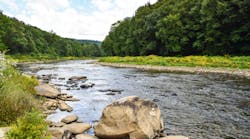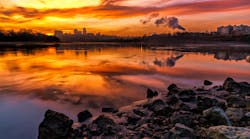Pend Oreille County, Wash., needed to remove a culvert on Indian Creek in New Port that was preventing bull trout from traveling upstream to spawn; the bull trout is a threatened species under the U.S. Endangered Species Act, and the stream is considered environmentally sensitive. Additionally, the county needed to address the road’s condition. Its alignment was for a 35 mile-per-hour (mph) road, but the speed limit is 50 mph. It was determined that the road should be realigned and the culvert replaced with a 58-ft single-span bridge to allow the fish to more easily move upstream and to correct the road condition. Limited physical and right-of-way access dictated that the earth-fill embankment approaches required for the new bridge would need steep wing walls.
The owner considered using steel sheet pile walls, but the cost exceeded the budget. Vinyl sheet pile walls did not meet the strength criteria. Also, residents and a local Native American tribe wanted a solution with a natural, vegetated look rather than a concrete wall along the wetland.
Pyrawall was selected because it is an engineered wrap-face, vegetated solution that costs less than a concrete retaining wall. In addition to yielding a natural look, the system’s bracing is all internal, creating a small footprint overall. It also can withstand animal loading expected from deer, antelope and moose in the area.
Pyrawall was used to build an east-approach embankment that is 210 ft long and 14 ft tall, and a west-approach embankment that is approximately 340 ft long and 18 ft tall. Once installed, the system provides immediate erosion control. The constructed wall will be 85% to 90% vegetated in four years and will provide erosion control protection for up to 75 years.







